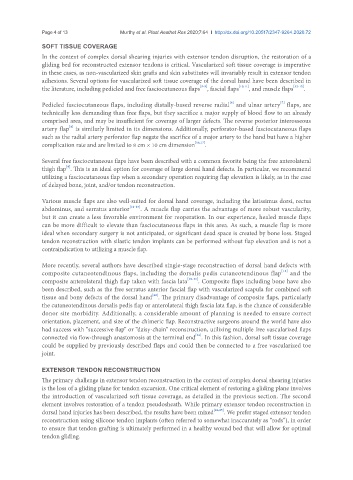Page 754 - Read Online
P. 754
Page 4 of 13 Murthy et al. Plast Aesthet Res 2020;7:64 I http://dx.doi.org/10.20517/2347-9264.2020.72
SOFT TISSUE COVERAGE
In the context of complex dorsal shearing injuries with extensor tendon disruption, the restoration of a
gliding bed for reconstructed extensor tendons is critical. Vascularized soft tissue coverage is imperative
in these cases, as non-vascularized skin grafts and skin substitutes will invariably result in extensor tendon
adhesions. Several options for vascularized soft tissue coverage of the dorsal hand have been described in
[5-9]
the literature, including pedicled and free fasciocutaneous flaps , fascial flaps [10,11] , and muscle flaps [12-15] .
[6]
[7]
Pedicled fasciocutaneous flaps, including distally-based reverse radial and ulnar artery flaps, are
technically less demanding than free flaps, but they sacrifice a major supply of blood flow to an already
comprised area, and may be insufficient for coverage of larger defects. The reverse posterior interosseous
artery flap is similarly limited in its dimensions. Additionally, perforator-based fasciocutaneous flaps
[8]
such as the radial artery perforator flap negate the sacrifice of a major artery to the hand but have a higher
complication rate and are limited to 8 cm × 10 cm dimension [16,17] .
Several free fasciocutaneous flaps have been described with a common favorite being the free anterolateral
[9]
thigh flap . This is an ideal option for coverage of large dorsal hand defects. In particular, we recommend
utilizing a fasciocutaneous flap when a secondary operation requiring flap elevation is likely, as in the case
of delayed bone, joint, and/or tendon reconstruction.
Various muscle flaps are also well-suited for dorsal hand coverage, including the latissimus dorsi, rectus
abdominus, and serratus anterior [12-15] . A muscle flap carries the advantage of more robust vascularity,
but it can create a less favorable environment for reoperation. In our experience, healed muscle flaps
can be more difficult to elevate than fasciocutaneous flaps in this area. As such, a muscle flap is more
ideal when secondary surgery is not anticipated, or significant dead space is created by bone loss. Staged
tendon reconstruction with silastic tendon implants can be performed without flap elevation and is not a
contraindication to utilizing a muscle flap.
More recently, several authors have described single-stage reconstruction of dorsal hand defects with
composite cutaneotendinous flaps, including the dorsalis pedis cutaneotendinous flap and the
[18]
composite anterolateral thigh flap taken with fascia lata [19-21] . Composite flaps including bone have also
been described, such as the free serratus anterior fascial flap with vascularized scapula for combined soft
[22]
tissue and bony defects of the dorsal hand . The primary disadvantage of composite flaps, particularly
the cutaneotendinous dorsalis pedis flap or anterolateral thigh fascia lata flap, is the chance of considerable
donor site morbidity. Additionally, a considerable amount of planning is needed to ensure correct
orientation, placement, and size of the chimeric flap. Reconstructive surgeons around the world have also
had success with “successive flap” or “daisy-chain” reconstruction, utilizing multiple free vascularized flaps
connected via flow-through anastomosis at the terminal end . In this fashion, dorsal soft tissue coverage
[23]
could be supplied by previously described flaps and could then be connected to a free vascularized toe
joint.
EXTENSOR TENDON RECONSTRUCTION
The primary challenge in extensor tendon reconstruction in the context of complex dorsal shearing injuries
is the loss of a gliding plane for tendon excursion. One critical element of restoring a gliding plane involves
the introduction of vascularized soft tissue coverage, as detailed in the previous section. The second
element involves restoration of a tendon pseudosheath. While primary extensor tendon reconstruction in
dorsal hand injuries has been described, the results have been mixed [24,25] . We prefer staged extensor tendon
reconstruction using silicone tendon implants (often referred to somewhat inaccurately as “rods”), in order
to ensure that tendon grafting is ultimately performed in a healthy wound bed that will allow for optimal
tendon gliding.

